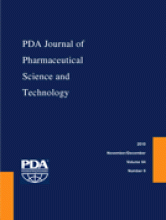Abstract
Through a detailed case study the authors demonstrate, for the first time, the capability of using advanced modeling techniques to correctly simulate the transient temperature response of a convective flow-based thermal shipper design. The objective of this case study was to demonstrate that simulation could be utilized to design a 2-inch-wall polyurethane (PUR) shipper to hold its product box temperature between 2 and 8 °C over the prescribed 96-h summer profile (product box is the portion of the shipper that is occupied by the payload). Results obtained from numerical simulation are in excellent agreement with empirical chamber data (within ±1 °C at all times), and geometrical locations of simulation maximum and minimum temperature match well with the corresponding chamber temperature measurements. Furthermore, a control simulation test case was run (results taken from identical product box locations) to compare the coupled conduction-convection model with a conduction-only model, which to date has been the state-of-the-art method. For the conduction-only simulation, all fluid elements were replaced with “solid” elements of identical size and assigned thermal properties of air. While results from the coupled thermal/fluid model closely correlated with the empirical data (±1 °C), the conduction-only model was unable to correctly capture the payload temperature trends, showing a sizeable error compared to empirical values (ΔT > 6 °C). A modeling technique capable of correctly capturing the thermal behavior of passively refrigerated shippers can be used to quickly evaluate and optimize new packaging designs. Such a capability provides a means to reduce the cost and required design time of shippers while simultaneously improving their performance. Another advantage comes from using thermal modeling (assuming a validated model is available) to predict the temperature distribution in a shipper that is exposed to ambient temperatures which were not bracketed during its validation.
LAY ABSTRACT: Thermal packaging is routinely used by the pharmaceutical industry to provide passive and active temperature control of their thermally sensitive products from manufacture through end use (termed the cold chain). In this study, the authors focus on passive temperature control (passive control does not require any external energy source and is entirely based on specific and/or latent heat of shipper components). As temperature-sensitive pharmaceuticals are being transported over longer distances, cold chain reliability is essential. To achieve reliability, a significant amount of time and resources must be invested in design, test, and production of optimized temperature-controlled packaging solutions. To shorten the cumbersome trial and error approach (design/test/design/test …), computer simulation (virtual prototyping and testing of thermal shippers) is a promising method. Although several companies have attempted to develop such a tool, there has been limited success to date. Through a detailed case study the authors demonstrate, for the first time, the capability of using advanced modeling techniques to correctly simulate the transient temperature response of a coupled conductive/convective-based thermal shipper. A modeling technique capable of correctly capturing shipper thermal behavior can be used to develop packaging designs more quickly, reducing up-front costs while also improving shipper performance.
- Cold chain
- Refrigerants
- Passive refrigeration
- Thermal packaging
- Insulated container
- Modeling
- Simulation
- Phase change material (PCM)
- Free convection
- Coupled thermal/flow
- © PDA, Inc. 2010
PDA members receive access to all articles published in the current year and previous volume year. Institutional subscribers received access to all content. Log in below to receive access to this article if you are either of these.
If you are neither or you are a PDA member trying to access an article outside of your membership license, then you must purchase access to this article (below). If you do not have a username or password for JPST, you will be required to create an account prior to purchasing.
Full issue PDFs are for PDA members only.
Note to pda.org users
The PDA and PDA bookstore websites (www.pda.org and www.pda.org/bookstore) are separate websites from the PDA JPST website. When you first join PDA, your initial UserID and Password are sent to HighWirePress to create your PDA JPST account. Subsequent UserrID and Password changes required at the PDA websites will not pass on to PDA JPST and vice versa. If you forget your PDA JPST UserID and/or Password, you can request help to retrieve UserID and reset Password below.






